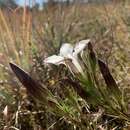en
names in breadcrumbs


Gentiana pennelliana, is a rare species of flowering plant in the genus Gentiana. It is commonly known as wiregrass gentian and grows in sections of the Florida panhandle.
Gentiana pennelliana was first described by Merritt Lyndon Fernald in 1940 and was named after American botanist Francis Whittier Pennell.[1]
This North American flowering plant is endemic to parts of the Florida panhandle, where it occurs naturally in pine flatwoods, wet prairies and seepage slopes.[2][3] It is adapted to fires and flowers in November to December, prolifically when stimulated by fires.
It is a perennial herb, which grows at approximately 20 cm (7.9 in) in height. The leaves are linear elliptic, 3–4 cm (1.2–1.6 in) long and widely spaced along the stem. The distinctive white tubular flowers, which are sometimes fringed with purple, are solitary and terminal, with a 7 cm (2.8 in) long flare at the opening with five entire lobes, alternating with five shorter fringed membranes.
Gentiana pennelliana, is a rare species of flowering plant in the genus Gentiana. It is commonly known as wiregrass gentian and grows in sections of the Florida panhandle.
Gentiana pennelliana was first described by Merritt Lyndon Fernald in 1940 and was named after American botanist Francis Whittier Pennell.
This North American flowering plant is endemic to parts of the Florida panhandle, where it occurs naturally in pine flatwoods, wet prairies and seepage slopes. It is adapted to fires and flowers in November to December, prolifically when stimulated by fires.
It is a perennial herb, which grows at approximately 20 cm (7.9 in) in height. The leaves are linear elliptic, 3–4 cm (1.2–1.6 in) long and widely spaced along the stem. The distinctive white tubular flowers, which are sometimes fringed with purple, are solitary and terminal, with a 7 cm (2.8 in) long flare at the opening with five entire lobes, alternating with five shorter fringed membranes.